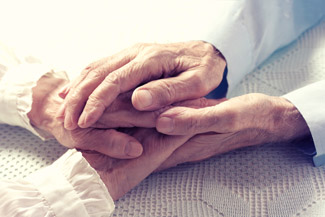Can we comfort others by simply holding their hands?
 Holding someone’s hand when they’re feeling stressed is a natural and often instinctive act, but not an insignificant one. A Franco-Israeli-American research team has just demonstrated the comforting power of human touch, in particular because it synchronizes the brain waves of the sufferer with those of the comforter. How can holding someone’s hand be helpful?
Holding someone’s hand when they’re feeling stressed is a natural and often instinctive act, but not an insignificant one. A Franco-Israeli-American research team has just demonstrated the comforting power of human touch, in particular because it synchronizes the brain waves of the sufferer with those of the comforter. How can holding someone’s hand be helpful?Today, the analgesic powers of social interaction, empathy, and physical contact remain unclear. The study, published in Proceedings of the National Academy of Sciences (PNAS) was carried out by researchers at the Universities of Colorado (US), Haifa (Israel), and Paris Diderot (France) with the goal of testing and analyzing interpersonal involvement (brain-brain coupling) in pain relief. The study’s lead author, Pavel Goldstein, a postdoctoral researcher studying pain at the Cognitive and Affective Neuroscience Lab (University of Colorado, Boulder) experienced this interpersonal synchronization first hand during his wife’s delivery. Indeed, he noticed that the pain diminished when he held her hand. Afterwards, he wanted to objectify his finding by verifying in the laboratory whether holding a suffering person’s hand could bring them comfort.
The research team recruited 22 heterosexual couples ages 23 to 32 who had been together for at least one year. The participants were presented with short scenarios (2 minutes) and their brain activity was recorded using an EEG (electroencephalogram). The couples experienced various situations: sitting together without touching, sitting together while holding hands, and sitting apart in separate rooms. The scientists then repeated the different scenarios while inflicting a slight pain (heat) to the woman's arm. What did the results reveal?
The researchers noticed the appearance of a certain synchronization between brain waves when participants were in their partner's presence. Whether or not the two were touching, synchronization was seen within a wavelength linked to focused attention. When the woman was suffering and her partner held her hand, the coupling increased. On the contrary, the synchronization decreased in the absence of physical contact. Thus, hand holding during pain administration increases brain-brain coupling in a network that primarily involves the central areas of the brain in the sufferer and the right hemisphere in the observer These results corroborate other research showing that holding the hand of a suffering person (for whom you have empathy) results in synchronized breathing and heart rate, but we now know that this harmonization also happens at the level of brain waves.
Subsequent tests related to the man's level of empathy have shown that the more the man empathizes with the woman’s pain, the greater the synchronization between the partners' brains, resulting in greater pain relief for the woman. The brain-brain coupling thus appears to be involved in the analgesic effect of touch. Further research is necessary to understand the neural mechanisms underlying this pain relief from brain synchronization. The authors hypothesize that brain mechanisms linked to reward “neutralize” part of the suffering.
Let’s conclude this article with a word from Pavel Goldstein: “We have developed a lot of ways to communicate in the modern world and we have fewer physical interactions. This paper illustrates the power and importance of human touch."
Source: Pavel Goldstein, Irit Weissman-Fogel, Guillaume Dumas, Simone G. Shamay-Tsoory. Brain-to-brain coupling during handholding is associated with pain reduction, in PNAS, Jan. 2018







